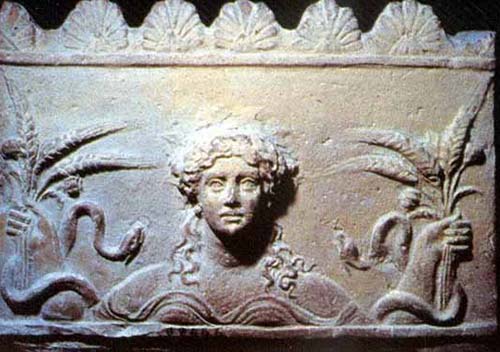In ancient Greece, this was the first day of the ELEUSINIAN MYSTERIES, during which the sacred objects were brought from Eleusis to Athens. The Mysteries were based on a legend concerning Demeter, the goddess of life, agriculture and fertility. According to the legend, Demeter’s daughter Persephone was gathering flowers with friends one day, when she was seen by Hades, the god of death and the underworld. Hades fell in love with Persephone and kidnapped her, taking her to his underworld kingdom.
Distraught, Demeter searched high and low for her daughter. In her distress, she neglected her duties; this caused a terrible drought in which the people suffered and starved.
According to the myth, during her search, Demeter traveled long distances and had many minor adventures along the way. In one instance, she teaches the secrets of agriculture to Triptolemus. Finally, by consulting Zeus, Demeter reunites with her daughter and the earth returns to its former verdure and prosperity: the first spring. Before allowing Persephone to return to her mother, Hades gave her seeds of a pomegranate.
As a result, Persephone could not avoid returning to the underworld for part of the year. According to the prevailing version of the myth, Persephone had to remain with Hades for four months while staying above ground with her mother for a similar period. This left her the choice of where to spend the last four months of the year and since she opted to live with Demeter, the end result was eight months of growth and abundance to be followed by four months of no productivity. These periods correspond well with the Mediterranean climate of Ancient Greece.
The four months during which Persephone is with Hades correspond to the dry Greek summer, a period during which plants are threatened with drought. After the first rains in the fall, when the seeds are planted, Persephone returns from the Underworld and the cycle of growth begins anew.
The Eleusinian Mysteries celebrated Persephone’s return, for it was also the return of plants and of life to the earth. Persephone had gone into the underworld (underground, like seeds in the winter), then returned to the land of the living: her rebirth is symbolic of the rebirth of all plant life during Spring and, by extension, all life on earth.
